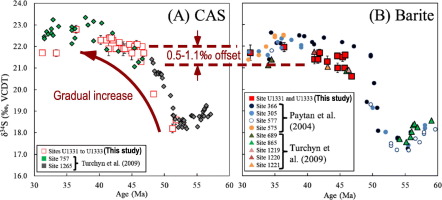当前位置:
X-MOL 学术
›
Chem. Geol.
›
论文详情
Our official English website, www.x-mol.net, welcomes your feedback! (Note: you will need to create a separate account there.)
Sulfur isotope ratios in co-occurring barite and carbonate from Eocene sediments: A comparison study
Chemical Geology ( IF 3.9 ) Pub Date : 2020-03-01 , DOI: 10.1016/j.chemgeo.2019.119454 Kotaro Toyama , Adina Paytan , Ken Sawada , Takashi Hasegawa
Chemical Geology ( IF 3.9 ) Pub Date : 2020-03-01 , DOI: 10.1016/j.chemgeo.2019.119454 Kotaro Toyama , Adina Paytan , Ken Sawada , Takashi Hasegawa

|
Abstract In order to investigate the utility of bulk carbonate as a recorder of seawater sulfate sulfur isotope ratios (δ34Ssw), co-existing pelagic barite and bulk carbonate in Eocene sediments from the Equatorial Pacific Ocean (IODP Exp. 320/321 Sites U1331 to U1333) were analyzed for their sulfur isotope ratios (δ34S). The δ34S from both minerals showed parallel fluctuation throughout the Eocene with carbonate associated sulfate (CAS) values about 0.8‰ heavier than those of barite. A similar offset was observed in CAS δ34S obtained using species-specific cleaned planktonic foraminifers in a previous study. The consistent results from two distinct minerals suggest that the original δ34Ssw can be derived from bulk CAS analysis, if post deposition carbonate recrystallization is minimal. The combined data set showed a ~5‰ increase of δ34Ssw during the Eocene (from 53 Ma to 36 Ma) with the majority of the shift within 7 myr between 53 and 46 Ma. This change is more gradual than previously reported. The timing of this δ34Ssw shift coincides with extensive pyrite burial in the Arctic Ocean, supporting the hypothesis that the 5‰ increase in Eocene δ34Ssw has been caused by 34S-enriched water outflow from the Arctic Ocean.
更新日期:2020-03-01



























 京公网安备 11010802027423号
京公网安备 11010802027423号